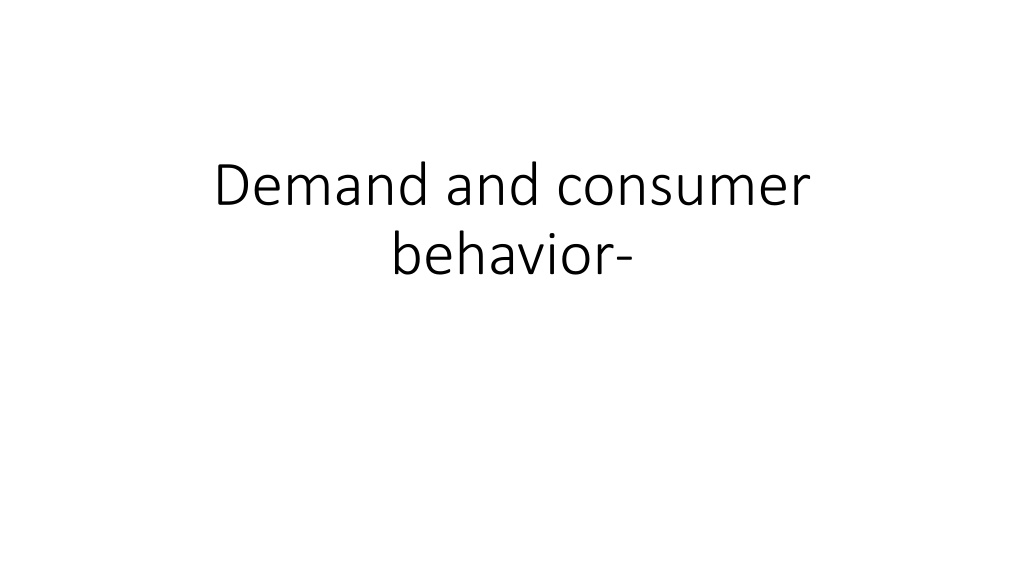Understanding Demand and Consumer Behavior in Economics
Demand in economics refers to the quantity of a commodity consumers are willing to buy at a given price within a specific time period. Various factors influence demand, such as price, consumer income, related goods prices, consumer preferences, advertising, and population size. Types of demand include direct and derived demand, recurring and replacement demand, complementary and competing demand, as well as demand for consumer goods and capital goods.
Download Presentation

Please find below an Image/Link to download the presentation.
The content on the website is provided AS IS for your information and personal use only. It may not be sold, licensed, or shared on other websites without obtaining consent from the author. Download presentation by click this link. If you encounter any issues during the download, it is possible that the publisher has removed the file from their server.
E N D
Presentation Transcript
Demand and consumer behavior-
Meaning of demand- Demand is the quantity of a commodity which the consumers are willing to buy at a given price for a particular unit of time. Demand is defined as that want, need or desire which is backed by willingness and ability to buy a particular commodity at a given point of time.
Determinants of demand- 1) Price of the product. 2) Income of the consumer. 3) Prices of related goods. 4) Tastes and preferences of the consumer. 5) Advertising. 6) Population.
Types of demand- 1) Direct and derived demand- a commodity may be demanded for various purposes like for consumption or for production of another commodity. When a commodity is demanded for its own sake i.e. by the final consumer it is known as a consumer good. Since these goods are demanded as they are their demand is direct demand. On the other hand when a commodity is demanded for using it as a raw material or as an intermediary for value addition in any other good or in the same good it is derived demand.
2) Recurring and replacement demand- consumable goods have recurring demand i.e. they are consumed at frequent intervals. The producers of these goods know that consumers make purchases on short term basis hence pricing is done accordingly. Durable consumer goods are purchased to be used for a long period of time. But they wear and tear over time due to use thus they have replacement demand.
3) Complementary and competing demand- goods which create joint demand are complementary goods therefore demand for one commodity is dependent upon the demand for the other one. On the other hand there are goods which compete with each other because they are substitutes. If a consumer is indifferent between two commodities they are close substitutes
4) Demand for consumer goods and capital goods- consumer goods are those which are sold to general consumers. They are brought by the ultimate consumers for their own personal use. The other type of goods are known as capital goods. These goods are demanded to use them as inputs in the production of other goods and services.
Law of demand- The law of demand states that other things remaining constant when the price of a commodity rises the demand for that commodity falls and when the price of the commodity falls the demand for that commodity rises . In other words the demand for the product is inversely proportional to its price. The demand function can be stated as follows- Dx = f( Px)
Assumptions of the law of demand- 1) Income of the person should remain constant. 2) Tastes, habits preferences should remain constant. 3) Prices of related goods should remain constant. 4) There should not be any expectations about any change in the price or income. 5) The size composition and growth of population should remain constant
Individual demand schedule- A demand schedule is the list or tabular statement of the different combinations of price and quantity demanded of a commodity.
Demand schedule- Price (Rs. Per cup) Demand (000 cups) 15 50 20 40 25 30 30 15 35 10
Market demand schedule- The market demand schedule is the sum of the individual demands of all the consumers at a given price.
Price of the commodity Quantity demanded A Quantity demanded B Quantity demanded C TOTAL 12 2 6 8 10 3 8 9 8 5 11 10 6 8 15 14 4 12 20 17 2 16 25 20
Exceptions to the law of demand- 1) Giffen goods- Sir Robert Giffen found this particular phenomenon in case of inferior goods it was observed that the demand for such goods decreased at a lower price and the demand increased at a higher price. This happened because the people preferred to consume some other superior commodity when the price of inferior goods decreased.
2) Brand loyalty- some customers are very loyal to certain brands thus even when the price increased they still continue to purchase the same commodity. 3) Snob appeal- there are certain goods which have a snob value for which the consumer measures the satisfaction derived from these commodities not by their utility value but by social status. The consumers of these goods want to show it off to others and as a result they buy less of it at a lower price and more at a higher price. Thus in this case the price and quantity move in the same direction.
4) Demonstration effect- when a persons behaviour is influenced by observing the behaviour of others activities this is known as demonstration effect. Demand for most of luxury items is governed by demonstration effect. In these type of goods price is not a governing parameter and goods are brought even though the prices are rising.
5) Future expectation of prices- it has been observed that when the prices are rising and it is expected that they will continue to rise in future the consumers buy more to keep a stock of the good. This happens when there is a natural calamity like famine or a flood. People expect that because of a famine there will be a shortage of supply of goods and thus they stock a good amount of the commodity mainly food grains at the currently rising prices.
6) Insignificant proportion of income spent- things of very low value and limited use like salt and matchbox do not show any impact of price on their demand. The reason is the amount spent on these goods is very small and even a large increase in their price has a negligible impact on money spent. Secondly these goods have limited use.
7) Goods with no substitutes- for goods which have no substitutes such as life saving drugs, petrol and diesel people have no option but to buy them whatever may be the price hence the demand does not show any effect of price change.























